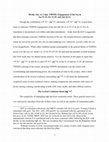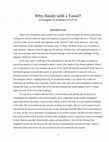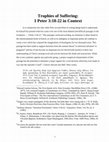Thesis Chapters by Andrew D Sargent, PhD

Though the combination <Y`h^ ug^r*, alternately <Y`h^ ug^r), is used three times to reference YHW... more Though the combination <Y`h^ ug^r*, alternately <Y`h^ ug^r), is used three times to reference YHWH's engagement of the sea (Job 26:12, Is 51:15 & Jer 31:35), its translation is inconsistent even within individual translations. 1 Aside from the KJV's suggestion that these passages reference YHWH's division of the sea, 2 the tension between rendering this clause he stirred the sea/who stirs the sea and rendering it he calmed the sea/who calms the sea is not insignificant. While either rendition speaks meaningfully to the general theme of YHWH's power over the sea, (cf. Jonah 1:4, 15-16; Ps 107:25-30) and each has parallels in both Scripture and ANE myth, they are distinct poetic pictures. It is my intention in this paper to argue that <Y`h^ ug^r*, in Job 26:12, and <Y`h^ ug^r), in Isa 51:15 and Jer 31:35, all reference YHWH's calming of the waters, picturing YHWH's domination over the waters with overwhelming and immobilizing power, the restoration of order to the cosmos. After a short consideration of the lexical confusion surrounding ug^r*, I will detail the fundamental exegetical issues in each scriptural context, making comparisons and contrasts with issues of divine stirring, calming, and dividing in both ANE water myths, and other biblical contexts. The Lexical Confusion about ug^r* The complexity of untangling ugr has been commonly noted. Three general senses (stir, rest, and quick), anywhere from one to three roots, as well as any number of connotation paths 1 KJV is consistent with divide, but MKJV switches Job 26:12 to quiet. Young's Literal is consistent with quiet. The NIV, ASV, JPS and RV are consistent with the equivalent of stir. Geneva has calm in Job, break in Jer, but divided in Isa. Bishops has still in Job, divide in Isa, but move in Jer. NASB, NRSV, ESV has stir in Isa & Jer, but still in Job. Most of the international versions I've considered tend to be more consistent either following the KJV with divide, or else rendering ugr stir. The one exception that I encountered was the Bulgarian which has stir for Job and Jer, but quell in Isa.

It is my intent in this thesis not only to establish the txyx as a tassel, which is symbolic of p... more It is my intent in this thesis not only to establish the txyx as a tassel, which is symbolic of priesthood, which is bestowed on every member of a kingdom of priests, a symbol whose intent was to provide a mnemonic trigger linking the Israelites' privileged status with the responsibilities associated with that honor, but it is also my intent to carry the reader on a tour of the process involved in arriving at this conclusion. The txyx is an adornment on the Hebrew garment, which itself has a broad symbolic life in the Semitic world, and is immediately attached to the garment's hem, which has an even broader symbolic life, particularly in the pages of the Bible. As extensions of the garment and the hem, txyx are special adornments reserved for those whose lives and roles support such symbolism. For this, the art and literary treasures of the ancient world must be scoured. The whole world of the ancient Near East, its histories, business records, covenant texts, myths, songs, proverbs and worship rituals must be laid bare as concerns these three elements of life. The dye chosen for these txyx is as significant as their location on the garment, and finds itself in the midst of many controversial issues concerning the identification of ancient colors and the symbolic significance given to them generally. The dye at hand (tlkt tekhlet) is but one color issue amid many related issues, whose proper interpretation is frequently skewed through spiritualizing zealots whose chief desire is to find Jesus hidden in every text. Even the construction of the txyx bares upon its interpretation as a mnemonic trigger, forcing the student into the world of holiness restrictions, town prostitutes, cloth manufacturing, and dye procedures. Even beyond being a symbol of priesthood, this bestowal is entwined within a narrative web in which its significance and its implications can best be appreciated, and abused. Thus, several contextual connotations may be drawn, and some warnings be taken, based on the theological ramifications of the location of this narrative within the book of Numbers.

As the result of a number of intersecting socio-religious phenomena, Gen 8:1 3 has remained a s... more As the result of a number of intersecting socio-religious phenomena, Gen 8:1 3 has remained a scholarly lacuna. It is often deemed a hopeless jumble of poorly woven ancient flood traditions, or to contain mere physical links in a scientifically sensible chain of events leading from flood to dry ground. Modern translations often render Gen 8:1 as a summary of events detailed thereafter in Gen 8:2ff. When the text concludes, <ymh wkvyw, one finds the equivalence of And God sent a wind to blow across the earth and the waters decreased. Ancient translations, however, interpret ikv as calmed and link jwr with its divine sense in Gen 1:2; one finds the equivalence of And God sent a wind to blow across the earth and the waters calmed.
In this dissertation, I will demonstrate that Gen 8:1-3 contains more than mere physical links in a chain of events leading from flood to dry land. Gen 8:1 describes the calming of the flood waters prior to the cutting off of their sources, and both Genesis 6-9 and 8:1 3 share meaningful aspects of battle patterns with ancient flood traditions, ANE chaoskampf texts, and significant biblical creation and kingdom texts. While Genesis 6-9 is, by ANE standards, historical narrative, describing a flood and its dispersal, its artistic nuances and theological truths are found within this mythopoetic setting.
Though the waters are merely waters, no more than material tools in YHWH's cleansing of the earth, Gen 8:1-3 describes, metaphorically, the turning point in YHWH's battle against the waters of the flood, describing their humbling defeat before the divine jwr, the cutting off of their life, and their scattering as YHWH reclaims the dry ground conquered by the waters in his re-creation of the inhabitable world with a new Adam and a new society based on divine law. Though the waters of the flood are created elements in complete submission to YHWH as creator, they remain, in the hearts of ancient readers, powerful and terrifying emblems of chaos, whose domination by YHWH in the flood story validates his lordship in convincing ways. The use of battle imagery without the necessity of actual battle emphasizes YHWH's power to rule over the whole of his creation.
Drafts by Andrew D Sargent, PhD
It is my intention, however, to provoke a consideration of the translation and interpretation of ... more It is my intention, however, to provoke a consideration of the translation and interpretation of Gen 8:1–3, not through our own modern scientific world–view, but, rather, in light of its ancient mythopoetic context. I will do this in two parts. In part I, I will use pertinent lexical and grammatical data, ancient interpretations, and ANE and Biblical parallels to establish the likelihood that shakak in Gen 8:1 speaks of a calming of the waters affected by the divine ruach which also cuts off the flood sources in 8:2 and drives the waters to their rightful place in 8:3. In part II, I will propose that this engagement of the waters in Gen 8:1–3 makes use of a powerful chaoskampf image common in both ANE literature and the Bible, declaring the unquestioned lordship of YHWH who dominates the sea with his ruach and brings from it the re–established order of the cosmos.
It is the purpose of this study to demonstrate the superiority of skeuos as wife, by considering ... more It is the purpose of this study to demonstrate the superiority of skeuos as wife, by considering Hellenistic, Old Testament, Rabbinic, and New Testament occurrences of skeuos and its synonym aggeion and by examining the immediate phrase context of skeuos in I Thess. 4:4.

Those who use the text to advance a descent into Hell with a proclamation to fallen angels have i... more Those who use the text to advance a descent into Hell with a proclamation to fallen angels have insisted on reading a very controversial first century teaching into what they deem a catechistic text which has no other support aside from other equally obscure passages which they interpret in its light. To interpret this passage as a double illustration of those who have suffered for the sake of righteousness and yet triumphed, fits perfectly with the flow of the passage, is grammatically possible, and is historically possible. To those about to face fiery trials for the sake of the testimony of Christ, Jesus and Noah are trophies of suffering. Jesus rose up from death in a better state, having brought as His reward, countless souls, before God. Noah, overcame the difficulties of the task ahead of him, endured misunderstanding, mockery, and societal abuse, and through his efforts was vindicated when the rains came—he lived, while his opponents died.
Conference Presentations by Andrew D Sargent, PhD
"The Ideological Underpinnings of Chaoskampf Motifs in Hebrew Poetry" briefly considers several s... more "The Ideological Underpinnings of Chaoskampf Motifs in Hebrew Poetry" briefly considers several significant passages that employ blatant chaoskampf motifs to speak of struggles against human threat, but will also highlight an ideological link between chaoskampf Myth and the biblical application of chaoskampf motifs to threats against life and societal stability. While one cannot reproduce ancient psychology, what phenomena of ANE and biblical religion can be observed suggest that life in the ANE was chaoskampf, a constant struggle against destructive forces within society, from abroad, in nature, and from the spirit realm. The diverse means by which this struggle is carried out says a good deal about the difference between biblical and ANE theology and practice and may provide the biblical theologian with appropriate categories for encapsulating biblical theology as a whole.
Papers by Andrew D Sargent, PhD
Theological Research Exchange Network - edocs.
Theological Research Exchange Network - edocs.
UMI, ProQuest ® Dissertations & Theses. The world's most comprehensive collection of dissert... more UMI, ProQuest ® Dissertations & Theses. The world's most comprehensive collection of dissertations and theses. Learn more... ProQuest, Wind, water, and battle imagery in Genesis 8:1--3. by Sargent, Andrew Dean, Ph.D., TRINITY ...











Uploads
Thesis Chapters by Andrew D Sargent, PhD
In this dissertation, I will demonstrate that Gen 8:1-3 contains more than mere physical links in a chain of events leading from flood to dry land. Gen 8:1 describes the calming of the flood waters prior to the cutting off of their sources, and both Genesis 6-9 and 8:1 3 share meaningful aspects of battle patterns with ancient flood traditions, ANE chaoskampf texts, and significant biblical creation and kingdom texts. While Genesis 6-9 is, by ANE standards, historical narrative, describing a flood and its dispersal, its artistic nuances and theological truths are found within this mythopoetic setting.
Though the waters are merely waters, no more than material tools in YHWH's cleansing of the earth, Gen 8:1-3 describes, metaphorically, the turning point in YHWH's battle against the waters of the flood, describing their humbling defeat before the divine jwr, the cutting off of their life, and their scattering as YHWH reclaims the dry ground conquered by the waters in his re-creation of the inhabitable world with a new Adam and a new society based on divine law. Though the waters of the flood are created elements in complete submission to YHWH as creator, they remain, in the hearts of ancient readers, powerful and terrifying emblems of chaos, whose domination by YHWH in the flood story validates his lordship in convincing ways. The use of battle imagery without the necessity of actual battle emphasizes YHWH's power to rule over the whole of his creation.
Drafts by Andrew D Sargent, PhD
Conference Presentations by Andrew D Sargent, PhD
Papers by Andrew D Sargent, PhD
In this dissertation, I will demonstrate that Gen 8:1-3 contains more than mere physical links in a chain of events leading from flood to dry land. Gen 8:1 describes the calming of the flood waters prior to the cutting off of their sources, and both Genesis 6-9 and 8:1 3 share meaningful aspects of battle patterns with ancient flood traditions, ANE chaoskampf texts, and significant biblical creation and kingdom texts. While Genesis 6-9 is, by ANE standards, historical narrative, describing a flood and its dispersal, its artistic nuances and theological truths are found within this mythopoetic setting.
Though the waters are merely waters, no more than material tools in YHWH's cleansing of the earth, Gen 8:1-3 describes, metaphorically, the turning point in YHWH's battle against the waters of the flood, describing their humbling defeat before the divine jwr, the cutting off of their life, and their scattering as YHWH reclaims the dry ground conquered by the waters in his re-creation of the inhabitable world with a new Adam and a new society based on divine law. Though the waters of the flood are created elements in complete submission to YHWH as creator, they remain, in the hearts of ancient readers, powerful and terrifying emblems of chaos, whose domination by YHWH in the flood story validates his lordship in convincing ways. The use of battle imagery without the necessity of actual battle emphasizes YHWH's power to rule over the whole of his creation.